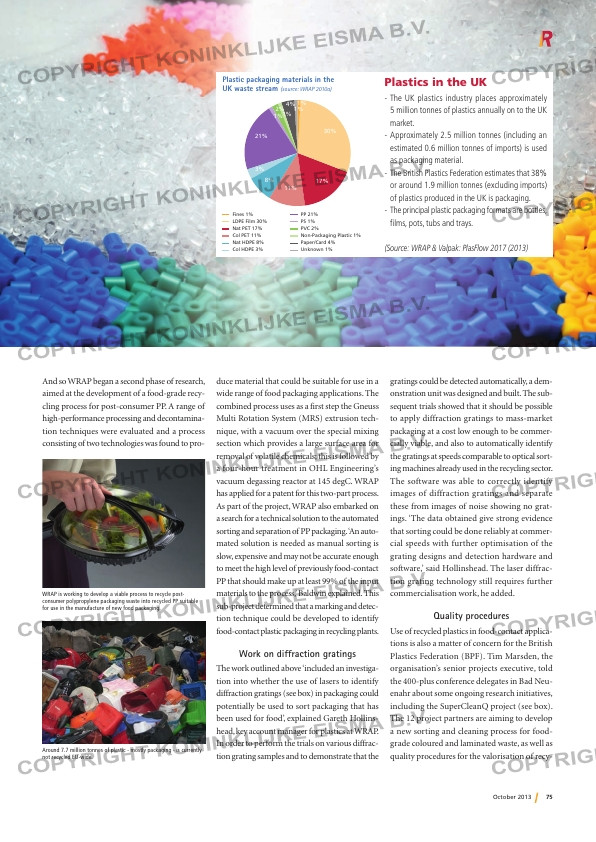Page 75 from: October 2013

75October 2013
And so WRAP began a second phase of research,
aimed at the development of a food-grade recy-
cling process for post-consumer PP. A range of
high-performance processing and decontamina-
tion techniques were evaluated and a process
consisting of two technologies was found to pro-
duce material that could be suitable for use in a
wide range of food packaging applications. The
combined process uses as a first step the Gneuss
Multi Rotation System (MRS) extrusion tech-
nique, with a vacuum over the special mixing
section which provides a large surface area for
removal of volatile chemicals; this is followed by
a four-hour treatment in OHL Engineering’s
vacuum degassing reactor at 145 degC. WRAP
has applied for a patent for this two-part process.
As part of the project, WRAP also embarked on
a search for a technical solution to the automated
sorting and separation of PP packaging. ‘An auto-
mated solution is needed as manual sorting is
slow, expensive and may not be accurate enough
to meet the high level of previously food-contact
PP that should make up at least 99% of the input
materials to the process,’ Baldwin explained. This
sub-project determined that a marking and detec-
tion technique could be developed to identify
food-contact plastic packaging in recycling plants.
Work on diffraction gratings
The work outlined above ‘included an investiga-
tion into whether the use of lasers to identify
diffraction gratings (see box) in packaging could
potentially be used to sort packaging that has
been used for food’, explained Gareth Hollins-
head, key account manager for plastics at WRAP.
In order to perform the trials on various diffrac-
tion grating samples and to demonstrate that the
gratings could be detected automatically, a dem-
onstration unit was designed and built. The sub-
sequent trials showed that it should be possible
to apply diffraction gratings to mass-market
packaging at a cost low enough to be commer-
cially viable, and also to automatically identify
the gratings at speeds comparable to optical sort-
ing machines already used in the recycling sector.
The software was able to correctly identify
images of diffraction gratings and separate
these from images of noise showing no grat-
ings. ‘The data obtained give strong evidence
that sorting could be done reliably at commer-
cial speeds with further optimisation of the
grating designs and detection hardware and
software,’ said Hollinshead. The laser diffrac-
tion grating technology still requires further
commercialisation work, he added.
Quality procedures
Use of recycled plastics in food-contact applica-
tions is also a matter of concern for the British
Plastics Federation (BPF). Tim Marsden, the
organisation’s senior projects executive, told
the 400-plus conference delegates in Bad Neu-
enahr about some ongoing research initiatives,
including the SuperCleanQ project (see box).
The 12 project partners are aiming to develop
a new sorting and cleaning process for food-
grade coloured and laminated waste, as well as
quality procedures for the valorisation of recy-
WRAP is working to develop a viable process to recycle post-
consumer polypropylene packaging waste into recycled PP suitable
for use in the manufacture of new food packaging.
Around 7.7 million tonnes of plastic – mostly packaging – is currently
not recycled EU-wide.
Plastic packaging materials in the
UK waste stream (source: WRAP 2010a)
1%
1%
4%
1%
2%
1%
30%
17%
11%
8%
3%
21%
Fines 1%
LDPE Film 30%
Nat PET 17%
Col PET 11%
Nat HDPE 8%
Col HDPE 3%
PP 21%
PS 1%
PVC 2%
Non-Packaging Plastic 1%
Paper/Card 4%
Unknown 1%
Plastics in the UK
– The UK plastics industry places approximately
5 million tonnes of plastics annually on to the UK
market.
– Approximately 2.5 million tonnes (including an
estimated 0.6 million tonnes of imports) is used
as packaging material.
– The British Plastics Federation estimates that 38%
or around 1.9 million tonnes (excluding imports)
of plastics produced in the UK is packaging.
– The principal plastic packaging formats are bottles,
fi lms, pots, tubs and trays.
(Source: WRAP & Valpak: PlasFlow 2017 (2013)
p00_Plastics UK.indd 75 03-10-13 14:14



